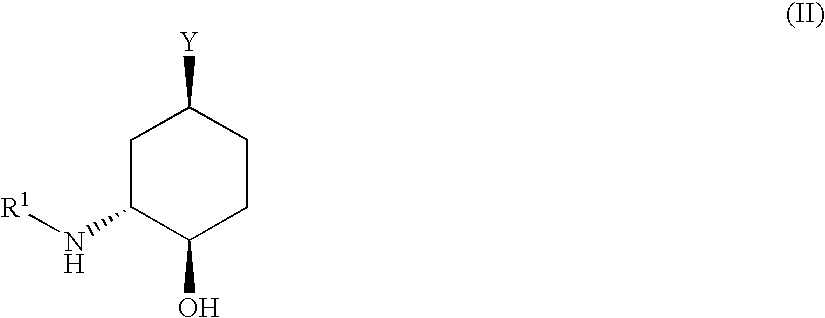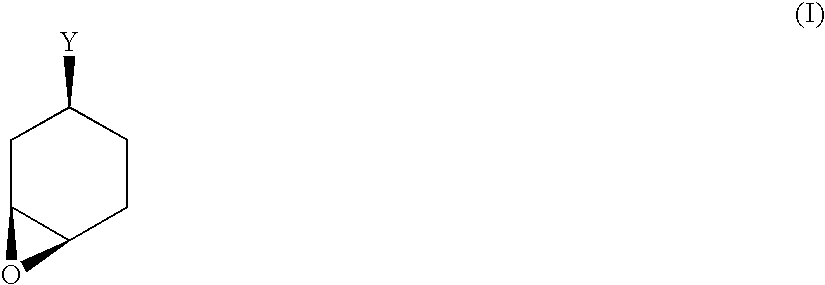Optically active diamine derivative and process for producing the same
- Summary
- Abstract
- Description
- Claims
- Application Information
AI Technical Summary
Benefits of technology
Problems solved by technology
Method used
Image
Examples
example 1
Ethyl (1S,3R,4R)-3-[(t-butoxycarbonyl)amino]-4-hydroxycyclohexanecarboxylate
[0366]Ethyl (1S,3S,6S)-7-oxabicyclo[4.1.0]heptane-3-carboxylate (5 g) was dissolved in ethanol (25 mL), and 28% aqueous ammonia (50 mL) was added to the solution at room temperature, followed by stirring at 40° C. for 24 hours. The solvent was evaporated under reduced pressure, to thereby yield 5.25 g of crude ethyl (1S,3R,4R)-3-amino-4-hydroxycyclohexanecarboxylate. The crude product was dissolved in ethanol (10 mL), and a solution (5 mL) of di-tert-butyl dicarbonate (7.69 g) in ethanol was added under ice-cooling to the solution, followed by stirring at room temperature for 1 hour. The solvent was evaporated under reduced pressure, and the residue was subjected to silica gel column chromatography (n-hexane:ethyl acetate=1:1), to thereby yield 5.42 g of the title compound.
[0367]1H-NMR (CDCl3) δ: 1.28 (3H, t, J=7.2 Hz), 1.45 (9H, s), 1.38-1.57 (2H, m) 1.86-1.95 (1H, m), 2.05-2.17 (1H, m), 2.29-2.39 (2H, m), ...
example 2
Ethyl (1S,3R,4R)-3-[(t-butoxycarbonyl)amino]-4-hydroxycyclohexanecarboxylate
[0369]2N Ammonia-ethanol solution (80 mL) was added at room temperature to ethyl (1S,3S,6S)-7-oxabicyclo[4.1.0]heptane-3-carboxylate (8 g), and the mixture was stirred in an autoclave at 75° C. for 72 hours. After completion of reaction, the solvent was evaporated under reduced pressure, to thereby yield 9.13 g of crude ethyl (1S,3R,4R)-3-amino-4-hydroxycyclohexanecarboxylate. The crude product was dissolved in ethanol (40 mL), and a solution (6 mL) of di-tert-butyl dicarbonate (11.28 g) in ethanol was added under ice-cooling to the solution. The mixture was stirred at room temperature for 15 hours, and the solvent was evaporated under reduced pressure. The residue was subjected to silica gel column chromatography (n-hexane:ethyl acetate=1:1), to thereby yield 9.95 g of the title compound. Spectral data of this compound were found to be identical with those of the compound of Example 1.
example 3
ethyl (1S,3R,4R)-3-[(t-butoxycarbonyl)amino]-4-hydroxycyclohexanecarboxylate
[0370]Saturated ammonia-ethanol solution (20 mL) was added at room temperature to ethyl (1S,3S,6S)-7-oxabicyclo[4.1.0]heptane-3-carboxylate (1 g), and the mixture was stirred in an autoclave at 50° C. for 72 hours. Thereafter, the solvent was evaporated under reduced pressure, to thereby yield 1.21 g of crude ethyl (1S,3R,4R)-3-amino-4-hydroxycyclohexanecarboxylate. The crude product was dissolved in ethanol (5 mL), and a solution (2 mL) of di-tert-butyl dicarbonate (1.28 g) in ethanol was added under ice-cooling to the solution. The mixture was stirred at room temperature for 1 hour, and the solvent was evaporated under reduced pressure. The residue was subjected to silica gel column chromatography (n-hexane:ethyl acetate=1:1), to thereby yield 1.46 g of the title compound. Spectral data of this compound were found to be identical with those of the compound of Example 1.
PUM
| Property | Measurement | Unit |
|---|---|---|
| Coagulation enthalpy | aaaaa | aaaaa |
Abstract
Description
Claims
Application Information
 Login to View More
Login to View More - R&D
- Intellectual Property
- Life Sciences
- Materials
- Tech Scout
- Unparalleled Data Quality
- Higher Quality Content
- 60% Fewer Hallucinations
Browse by: Latest US Patents, China's latest patents, Technical Efficacy Thesaurus, Application Domain, Technology Topic, Popular Technical Reports.
© 2025 PatSnap. All rights reserved.Legal|Privacy policy|Modern Slavery Act Transparency Statement|Sitemap|About US| Contact US: help@patsnap.com



